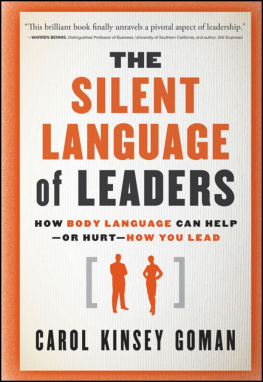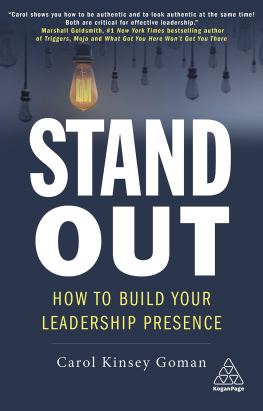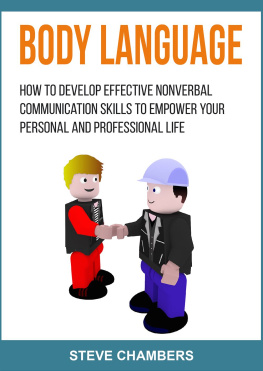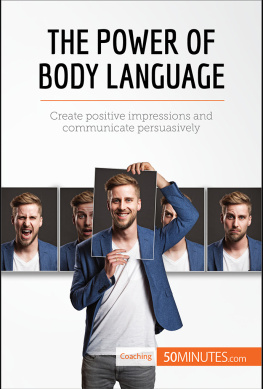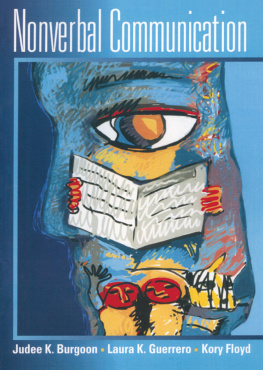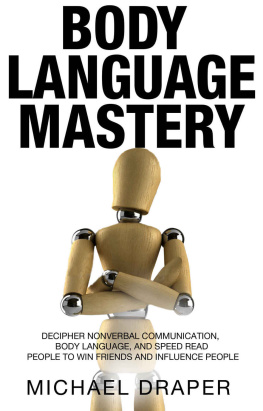Praise for The Nonverbal Advantage
Given todays technology-driven communication systems, people have fewer face-to-face interactions. As a result, it is crucial to maximize their impact. Dr. Goman provides a valuable guide for doing just that by helping the reader understand how the nonverbal aspects of a conversation often say much more than the verbal ones.
Jon Peters, President, The Institute for Management Studies
The Nonverbal Advantage takes a fresh look at body language as an essential executive management skill. This is a must-read for anyone who is responsible for negotiating or facilitating change in their professional association.
Alan Sauer, CAE, IOM, Fellow, American Society of Association Executives, and former Chair of the Board of Trustees, U.S.
Chamber of Commerce Institute for Organization Management
This book happens to hit on one of my hot buttons. I have made numerous speeches on communication, which I consider the common denominator of success or failure. Invariably, people do not reflect on body language as a means of communication until you bring it to their attention. The Nonverbal Advantage should be a great success!
Charles A. Lynch, Chair, Market Value Partners Company
Face-to-face communication takes on a new meaning in this much-needed and detailed treatise on nonverbal communication. Understanding how humans give silent clueswith eyes, hands, posture, and even feethelps us become better speakers and better listeners.
Wilma Mathews, ABC, IABC Fellow, Faculty Associate,
Walter Cronkite School of Journalism and Mass
Communication, and Communication Consultant
Carol Kinsey Goman shows you how to use body language skills to build stronger professional relationships. The Nonverbal Advantage is a must-read for anyone wanting to move ahead and stand out from the crowd.
Robert L. Dilenschneider, Founder and Principal,
The Dilenschneider Group, and author of
Power and Influence: The Rules Have Changed
In my global business dealings, Ive seen negotiations fall apart when people gave the wrong signals and didnt respect cultural differences. The Nonverbal Advantage should be required reading for anyone in sales or negotiationsespecially if they work internationally.
Kimberly Benson, Vice President, Cange International, Inc.
In a brave new world brimming with discovery and invention, we must remember to update our existing human-insights skill set. Now is the time to renew your toolbox by including knowledge of the nonverbal cues that will take center stage in business and in life. Carol Kinsey Gomans book is a timely read indeed.
Watts Wacker, futurist and coauthor of Whats Your Story?
Storytelling to Move Markets, Audiences, People, and Brands
The Nonverbal Advantage is a fresh look at employee communication management and the more subtle, but nevertheless important, cues of body language. Gomans analysis of interpersonal communication techniques, signals, and behaviors suggests that nonverbal signals are more important in understanding human behavior than words alonethe nonverbal channels seem to be more powerful than what people say. She is pointing the way for managers at all levels.
Deborah Radman, APR, Fellow PRSA,
Senior Vice President/Director, CKPR
In the second half of my thirty-three-year career in law enforcement, my interview ability and success took a definite upswing after taking training that addressed not only verbal deception but also nonverbal behavior. Carols book takes many of the things I learned about body language and puts them in a form that any manager or business professional can use.
Robert Baker, retired San Diego County District Attorney
Investigator and San Diego County Sheriff Detective
The Nonverbal Advantage
The Nonverbal Advantage
Secrets and Science of
Body Language at Work
Carol Kinsey Goman

The Nonverbal Advantage
Copyright 2008 by Carol Kinsey Goman
All rights reserved. No part of this publication may be reproduced, distributed, or transmitted in any form or by any means, including photocopying, recording, or other electronic or mechanical methods, without the prior written permission of the publisher, except in the case of brief quotations embodied in critical reviews and certain other noncommercial uses permitted by copyright law. For permission requests, write to the publisher, addressed Attention: Permissions Coordinator, at the address below.

Ordering information for print editions
Quantity sales. Special discounts are available on quantity purchases by corporations, associations, and others. For details, contact the Special Sales Department at the Berrett-Koehler address above.
Individual sales. Berrett-Koehler publications are available through most bookstores. They can also be ordered directly from Berrett-Koehler: Tel: (800) 929-2929; Fax: (802) 864-7626; www.bkconnection.com
Orders for college textbook/course adoption use. Please contact Berrett-Koehler:
Tel: (800) 929-2929; Fax: (802) 864-7626.
Orders by U.S. trade bookstores and wholesalers. Please contact Ingram Publisher Services, Tel: (800) 509-4887; Fax: (800) 838-1149; E-mail: customer.service@ingrampublisherservices.com; or visit www.ingrampublisherservices.com/
Ordering for details about electronic ordering.
Berrett-Koehler and the BK logo are registered trademarks of Berrett-Koehler Publishers, Inc.
First Edition
Paperback print edition ISBN 978-1-57675-492-4
PDF e-book ISBN 978-1-57675-774-1
IDPF e-book ISBN 978-1-60509-905-7
2010-2
Interior design and composition by Gary Palmatier, Ideas to Images.
Elizabeth von Radics, copyeditor; Mike Mollett, proofreader; Medea Minnich, indexer.
Cover design by PemaStudio.
Dedication
To Skip because I love him,
to Joyce because shes always in my corner,
and to Toni because shes my best friend and favorite sister
Introduction
The most important thing in communication is hearing what isnt said.
Peter F. Drucker
HAVE YOU EVER WONDERED
What kind of impression am I making?
Should I believe what my boss told me?
Am I dealing with a potential buyer, or am I just wasting my time?
Did my whole team understand what I said?
What did the customer mean by that?
How do I know if he really supports my idea?
Is the audience angry, frustrated, interested, or bored?
The answers to such questions are right before your eyes. Thats because people in professional settings are constantly telling each other exactly what they think and feeland it often has nothing to do with the words they speak. Your boss may say that youll be considered for a promotion, but if shes leaning back with crossed arms and a forced smile, shes sending the opposite message. The customer may say hes not interested in buying that new car, but if he keeps glancing at the contract on the table, hes telling you that he
Next page

